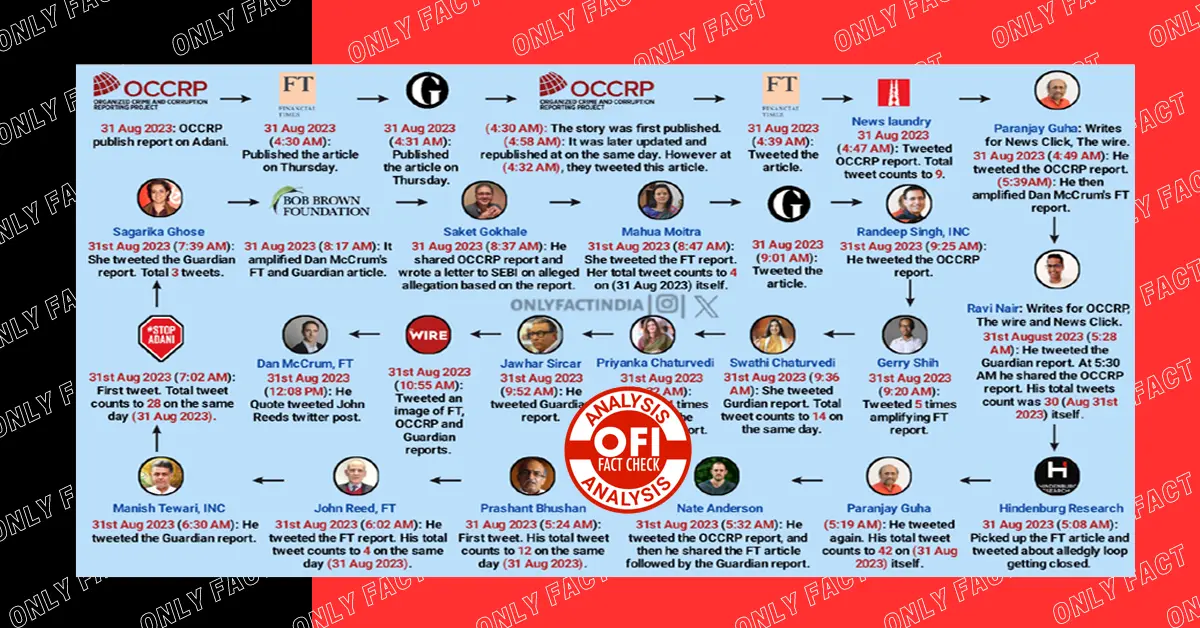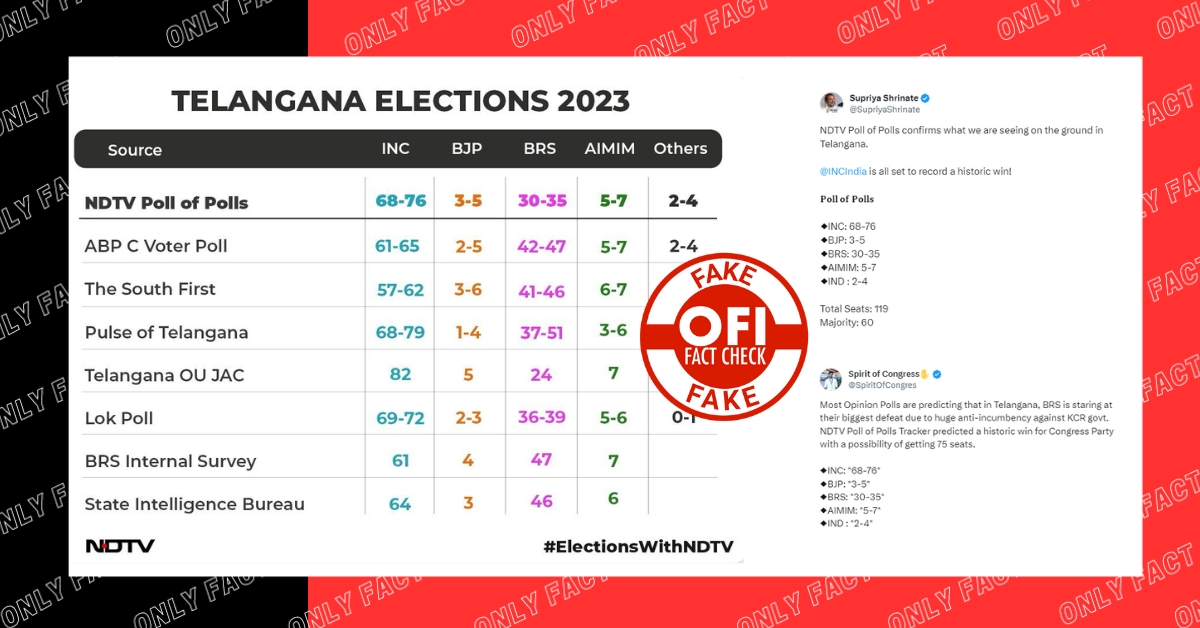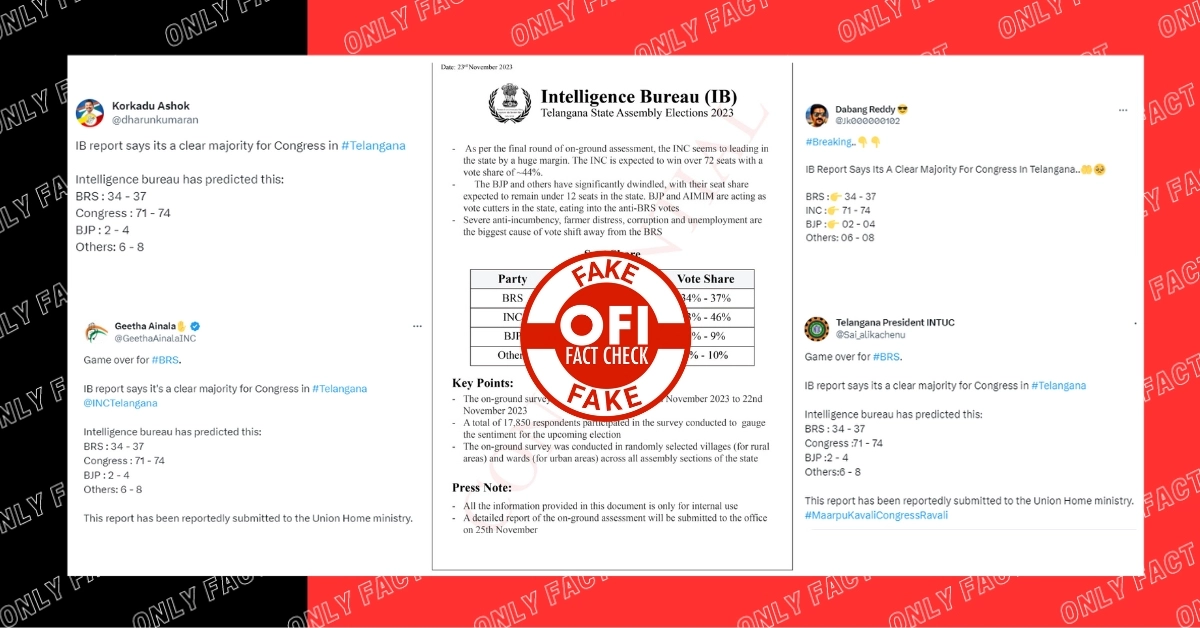A few days ago, the entire left-leaning lobby, from The Wire to Abhisar Sharma, propagated a false narrative linking Gautam Adani to the Uttarkashi Silkyara Tunnel Mishap. This incident prompted us to reflect on recent fabricated stories targeting the Adani Group. In this article, we will examine how influential entities collaborated with the singular aim of undermining India’s top businessman, Gautam Adani.
We will scrutinize the narrative initially disseminated by the Organized Crime and Corruption Reporting Project (OCCRP), later echoed by the Financial Times and various other media outlets, and subsequently amplified by individuals with a specific agenda.
OCCRP released an article on its website about Adani, claiming to present new evidence of stock manipulation at 4:30 am on August 31.
Shortly after, the Financial Times published an article on the same topic on their website, citing OCCRP as their source at 4:31 am.
Furthermore, the English newspaper The Guardian also reported on the same, using the same source at the same time as the Financial Times, i.e., 4:31 am.
OCCRP then published an article on X at 4:32 am on October 31, with a caption stating, “Now reporters have found new evidence that sheds light where the authorities couldn’t.”
Following OCCRP’s lead, Financial Times shared their article on X at 4:39 am.
Newslaundry swiftly asserted that the documents received from OCCRP unravel a mystery and promptly published an article, sharing it on X at 4.47 am. The article is co-authored by three individuals, including the notorious Ravi Nair, who co-authored the original OCCRP report and has been active on this topic on X since 5 in the morning. In total, Newslaudary tweeted on the topic 9 times on 31st August.
Also Read: Newsclick Raid Links Rooted in Chinese Connections, Not Adani Criticism
Now, let’s look at the individuals who amplified the story from OCCRP, FT, and The Guardian.
Paranjoy Guha Thakurta, founder, and editor of Newsclick, who has faced allegations of money laundering and receiving funds from the Chinese communist regime to promote their agenda, tweeted the OCCRP article in the early hours, specifically at 4:49 am.
Later, Thakurta left no stone unturned as he amplified the Financial Times report written by Dan McCrum at 5:39 am.
Ravi Nair, also one of the authors of the OCCRP article, tweeted his co-authored piece at 5:28 am. Following this, Nair proceeded to tweet the FT and The Guardian articles showcasing a case of a meticulously planned hit-job accompanied by an obsessive disorder targeting an individual with the sole aim of damaging his reputation and wealth.
Paranjoy Guha Thakurta and Ravi Nair exhibited a relentless commitment to tweeting against Adani, starting in the early hours when most people, and even birds, were still asleep. Thakurta and Nair seemed to wake up with the sole purpose of tweeting against Adani as much as possible. Ravi Nair engaged in an extensive series of 30 tweets within a single day, all centred around the same topic.
Delving further into the orchestrated attack against the Indian businessman, Hindenburg Research, known for such short-seller-type attacks, tweeted the FT article at 5:08 am, expressing, “Finally, the loop is closed.”
Despite a brief pause, Newsclick founder Paranjoy Guha Thakurta couldn’t stay out of action for long. He resumed tweeting at 5:19 am. October 31 turned out to be one of the busiest days for Thakurta, as he tweeted non-stop 42 times against Adani until his fingers, fueled by CCP funds, seemingly ran out of gas.
Shortly after Hindenburg’s tweet, their favored hit-man, Nate Anderson, tweeted the OCCRP article at 5:32 am, followed by the FT and The Guardian articles.
The cynosure of criminals and islamic terrorists’ eyes, Lawyer Prashant Bhushan entered the fray, first tweeting about the topic at 5:24 am. Bhushan didn’t limit himself; he continued tweeting 12 posts about Adani on the same day. Recently, the Supreme Court of India once again dismissed Bhushan’s stance on the Adani issue, stating that the FT and The Guardian articles are not reliable evidence.
Nilutpal Timsina of Reuters promptly released an article at 4:57 am, attributing information to OCCRP as the primary source.
John Reed, the South Asia bureau chief of FT, tweeted the FT article at 06:02 am, accompanied by a series of four tweets against the Indian business tycoon.
John Reed, following the sharing of the FT article, also posted the OCCRP article at 6:11 am.
The Print, founded by Shekhar Gupta, promptly published a report on the topic as early as 6:15 in the morning. However, The Print shared it on X at 8:52 am.
Steve Herman, a journalist associated with Voice of America, published the story on his blog, drawing inspiration from the OCCRP report at 6:15 am.
The concocted story against Adani soon found its way into the drawing room of Indian National Congress politician Manish Tiwari, who tweeted The Guardian article at 6:30 am.
Several years ago, a massive protest against the Adani group took place in Australia. Reportedly, the Adani group was snatching businesses from China’s lap. China had significant economic and political influence in Australia. To thwart Adani’s business activities in Australia, environmental activists raised the “Stop Adani” slogan. This slogan, later turned into a Twitter account with 15.7k followers, tweeted 28 times about the FT’s article at 7.02 am.
John Reed was resolute in advancing the anti-Adani narrative to the extent that, in his capacity as the bureau chief at FT, he shared the identical article published by The Guardian at 7:27 am.
Sagarika Ghose, an independent columnist often criticized for promoting anti-India narratives, tweeted The Guardian article at 7:39 am. Ghose tweeted four times calling the report explosive report 2.0.
The Bob Brown Foundation, known for destabilizing businesses under the guise of environmental concerns, tweeted the FT article at 8:17 am.
In lockstep with the promotion of the communist agenda and anti-Modi narrative, The Newsminute acted swiftly to publish the report at 8:26 am and shared it on X by 8:30 am.
Rajya Sabha MP Saket Gokhale, a prolific disseminator of misinformation who has faced numerous criticisms for spreading fake news, posted a tweet at 8:37 am referring to the OCCRP article. Interestingly, in the early morning hours, Gokhale had penned a two-page letter to the SEBI chairperson, urging an investigation into the matter.
TMC MP Mahua Moitra, facing serious allegations of misusing her parliamentary post and often attributing every problem in her life to Gautam Adani, tweeted the FT story at 8:47 am and later The Guardian story at 9:01 am.
Congress leader Randeep Singh Surjewala, following in the footsteps of Manish Tiwari, became the second Congress leader to tweet on this carefully crafted story, sharing the OCCRP article at 9:25 am.
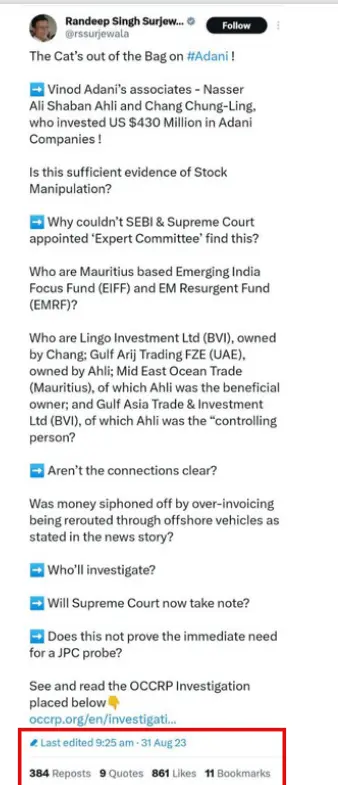
Gerry Shih, the Washington Post India bureau chief known for attempting to tarnish the image of the Adani group, tweeted 6 times, amplifying the FT story at 9:20 am. Shih tried hard to help FT complete the job, but alas, FT failed miserably.
Free press journal published a report on the topic calling it Hindenburg 2.0 at 9.28 am.
Swati Chaturvedi, a prominent member of the anti-India lobby, shared The Guardian article against Adani at 9.36 am. Chaturvedi then went on a tweeting spree, sharing 14 tweets on the same topic on the same day.
Priyanka Chaturvedi, a Rajya Sabha member from Uddhav Thakray’s Shivsena group, tweeted four times, quoting The Guardian article at 9.32 am.
Jawhar Sircar, a Rajya Sabha MP from TMC known for his blind hatred against Indian Prime Minister Narendra Modi, tweeted at 9:52 am.
Congress leader Dr. Shama Mohammad joined the clamor against the Adani group at 10:16 am.
The Stop Adani handle, presenting itself as an environmental activist, exhibited an unusual focus on financial matters and posted its second tweet at 10:34 am.
The Wire, which thrives on propagating a communist agenda and baseless attacks on the Adani group, tweeted an image of FT, OCCRP, and The Guardian articles at 10:55 am.
The official Congress handle contributed to the propaganda by sharing the unfounded allegations from the OCCRP report at 11:27 am.
While the founder of Newsclick woke up earlier than the birds, his organization published their report calling it “Hindenburg 2.0” at 11:36 am.
Dan McCrum, a journalist at FT, quote-tweeted John Reed’s Twitter post at 12:08 pm.
At 4:42 pm, OCCRP shared the press conference held by Rahul Gandhi on the same topic, indicating the success of their targeted attack influencing the Indian opposition. In essence, the quid-pro-quo deal is evident to the naked eye.
By 8:37 pm, Congress leader Rahul Gandhi tweeted using The Guardian report, raising questions about the relationship between businessman Gautam Adani and PM Modi.
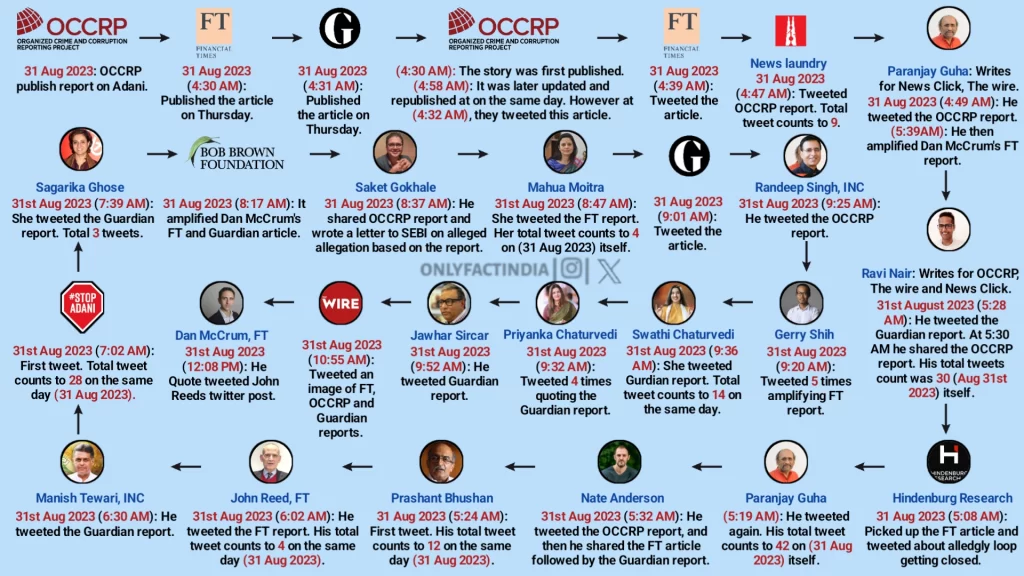
On August 31, a meticulously orchestrated and collaboratively disseminated narrative unfolded across various channels, spreading unfounded allegations against the Adani Group. The origin of this carefully concocted story can be traced to publications in the United States and Europe, highlighting the concerted efforts to tarnish the reputation of an Indian businessman. The events of that morning underscore the extensive measures these influential organizations are willing to take to cast a shadow on the image of an Indian entrepreneur. Summing it up by quoting the recent judgement of the Supreme Court of India, “We don’t have to treat what is set out in the Hindenberg report as ipso facto a true state of affairs.”
Also Read: Financial Times allegation on Adani Group Exposed, Link Rooted to George Soros

